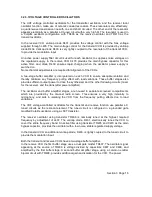
required for the total front end filtering are mechanically pre-aligned by the tuning cores, but
once set require no further readjustment.
Conversion to the first IF frequency of 21.4MHz is achieved with the double balanced ring
diode mixer U400.
3.2.1.3 IF SECTION
Following the double balanced mixer module U400, an IF pre-amplifier, TR401, provides
additional IF gain and also presents a suitable impedance match to the crystal filter FL403.
Further IF amplification is provided at 21.4MHz by TR402, and this stage is also designed to
load the crystal filter with an optimum load impedance. Approximately 30dB of overall gain is
provided at 21.4MHz ahead of the second IF conversion.
IC400 contains the receiver second mixer and second local oscillator, limiter amplifiers
operating at the second IF frequency of 455kHz, and the FM de-modulator.
The 21.4MHz signal is connected to the input of the second mixer at PIN 16 of IC400. The
second local oscillator has its active components internal to IC400 with the crystal reference,
XL400, connected externally at PIN 1.
The output of this second mixer appears at PIN 3, and here the second IF difference
frequency of 455kHz is filtered by a ceramic filter, FL404. This filter provides the final stage of
adjacent channel rejection, and it's performance in conjunction with FL403 provides the overall
selectivity of better than 75dB. FL403 also has sufficient selectivity to reject the second image
at 910kHz offset.
The IF signal at the output of the second mixer (PIN 3) is processed externally to IC400, by
the noise blanker option when this module is fitted to SK401.
Following FL404 are a cascade of limiter amplifiers, within IC400 which is ahead of the FM de-
modulator, in the form of a quadrature detector using the tuned circuit of L404. This tuned
circuit is adjusted to 455kHz, and a frequency modulated input to this circuit produces the
demodulated audio output which appears at PIN9 of IC400.
3.2.1.4 RECEIVE AUDIO PROCESSING
Refer to figure 3.3.
The demodulated audio available at PIN 9 of IC400 is first processed by one stage of the quad
OP-AMP IC401. This stage provides three functions:
i)
Low pass filter with a cutoff of l00kHz to remove residual 455kHz components of the
demodulated audio.
ii)
Amplification of the audio signal to an optimum level, approximately 700mV rms for a
60% deviation.
iii)
Temperature compensation of audio gain. The temperature compensation is required
to ensure a predictable mute circuit operation over a wide temperature range. The
output of this OP AMP stage is split into three paths.
Section 3 Page 6
















































